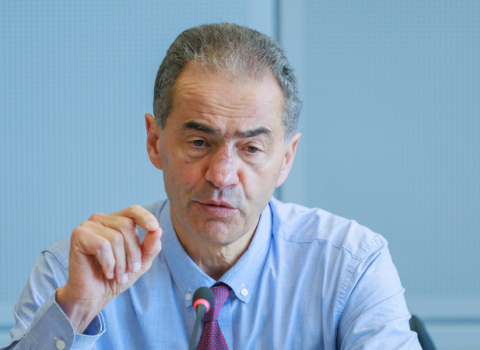The early votes are in: Many research and innovation organisations in Europe say they want the European Commission to create a new innovation agency – but have big differences of opinion over its ideal size and scope.
The idea of a European Innovation Council, to stimulate more innovation in Europe, was first floated by EU Research Commissioner Carlos Moedas in mid-2015, and a public call for ideas was announced 16 February at a Science|Business conference.
Since then, the Commission has proceeded internally to shape the idea of an EIC – and on May 25 Moedas outlined a plan to fellow-Commissioners to build the new body around an existing small-business programme, the €2.8 billion SME Instrument, design an advisory board of investors and business experts, and make it easier for small businesses to find out about EU support programmes. But several specifics remain to be decided this Autumn, including what powers the Council will have and whether other SME programmes – such as Eureka, Fast Track to Innovation and Future Emerging Technologies – would be in some way affiliated with the new EIC. A pilot EIC is due to begin in 2018.
The public call for ideas, however, was an important step in rallying the major players in Europe’s research and innovation world behind the idea – and it appears that at least some of the ideas floated in the responses were heeded by the Commission in its preliminary plans.
The Commission has gradually published the results of its public consultation on the EIC, which ended on April 29. On its website are the views of 109 groups, many of which gave strong support to the proposal. The Commission’s own analysis on consultation results will be published later this month.
Here are some of the main takeaways.
Government agencies point to SME Instrument
The biggest backers of building the EIC around existing SME programmes were member-state innovation agencies.
A group including Finland’s Tekes, Innovate UK, Flanders Innovation & Entrepreneurship, the Austrian Research Promotion Agency and Innovation Norway all broadly agree that the EIC should build on Horizon 2020’s SME Instrument.
Because of its relatively flexible legal basis, the SME Instrument is considered a good place to base the EIC pilot. This approach might also avoid having to go back to the European Parliament for new legislation – a risky process in these politically volatile times.
The agencies also recommend that several innovation competitions in Horizon 2020 should be merged under the EIC. Tekes, for example, calls for the SME Instrument to be fused with the Fast Track to Innovation scheme, whose main feature is a permanently open competition.
“The instruments clearly need more money; they should both be genuinely bottom-up, meaning free from thematic allocations; the funding ‘calls’ should be constantly open [and] the procedures must be fast and easy”, it writes.
What should it do?
What mattered to most respondents was that the EIC be funded with fresh money instead of diverting old money from the Horizon 2020 budget.
“The high oversubscription and generally very low application success rates in Horizon 2020… are of great concern to our universities. Therefore, the EIC should not be funded from the existing Horizon 2020 budget,” says a joint statement from CESAER, EuroTech Universities Alliance, IDEA League, CLUSTER and Nordic Five Tech, which between them represent over 50 universities in 24 countries.
The scope of the new Council was a more contested issue.
Aarhus University says the EIC needs “a strong focus on simplicity, excellence, shorter time lags [and] expert reviews.”In its submission, the Estonian ministry of education and research writes that the EIC should promote closer cooperation between higher education and research institutions and companies.
“This is a gap that, for instance, the European Institute of Innovation and Technology has not been able to successfully address,” it says.
Belgium’s Free University of Brussels imagines an expansive role for the EIC – one that would see it become a sort of EU executive agency with responsibility for all existing innovation-related instruments.
But several organisations, such as the European Universities Association and Germany’s Federation of German Industries, would like to see the EIC act mainly as an advisory body.
Not everyone agreed that the EIC should do anything other than manage grants, however. In the view of Sweden’s KTH Royal Institute of Technology, “Europe does not need another policy body”.
It shouldn’t even be a physical body, according to a joint-submission from the universities of Leeds, Sheffield and York – instead, “a virtual institution acting as a signposting mechanism to numerous other funding and investment schemes.”
Innovation Norway, meanwhile, says the Council should be a think-tank for innovation policy as well as “a partner for relevant national ministries”.
While the League of European Research Universities says it would prefer to see any new capabilities or roles added to existing instruments.
Quicker grants
There’s general agreement that the EIC should award grants quicker. Currently in Horizon 2020, a funding decision takes about a half year.
Silicon Valley’s popular talent-spotter, the Y Combinator incubator, should be a model for the EIC, writes Piotr Jakubowicz, co-founder of Sothic Bioscience, an Irish firm.
“It takes a half a day to make an application [to] Y Combinator and a couple of emails to clarify questions regarding the business model. The airplane tickets to San Francisco are paid for, so is the stay in the hotel.
“After a 10 minute long interview, the decision to get an investment at $120,000 for approximately 7 per cent equity or convertible loan notes is made on the same day,” he adds.
Who do you put in charge?
There is some debate over who is best fit to run the EIC.
According to Luxembourg’s LDS Venture Capital, “it is implausible that [public] initiatives are the best way for creating world-beating businesses. Venture capitalists have the experience, the processes and incentives needed to select those disruptive, market-creating innovations needed to catapult European ideas into global markets.”
Similarly, the Royal Institute of Technology advises “against empowering public officers or committees to act as decision makers in the selection of supported companies.
“Trying to pick the winners is a difficult task and a strict business finance perspective must be employed,” it adds.
Other ideas
According to Nesta, the UK’s innovation foundation, the EIC should be in charge of several challenge prize competitions.
“There are many areas ripe for challenge prizes, from emerging technologies like blockchain to health-enhancing foods,” it writes.
Both the French Competitiveness Clusters Alliance and Germany’s research society Fraunhofer recommend that the EIC runs a “voucher” reward system for small grants worth €50,000. Dutch electronics multinational Philips recommends that the EIC runs a fund-of-funds scheme.
The UK’s Royal Academy of Engineering encourages the Commission to build in requirements for corporate co-investment in all EIC grants, “to ensure the private partner has skin in the game”.
Strathclyde University says the costs of patenting for SMEs should be eligible for funding from the EIC. It also suggests the new instrument should co-invest in projects jointly run by European universities and institutes in rich countries like South Korea.





 A unique international forum for public research organisations and companies to connect their external engagement with strategic interests around their R&D system.
A unique international forum for public research organisations and companies to connect their external engagement with strategic interests around their R&D system.